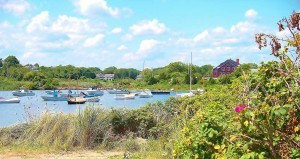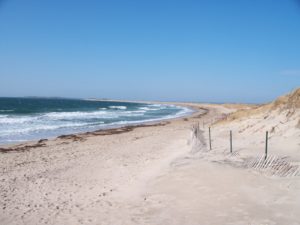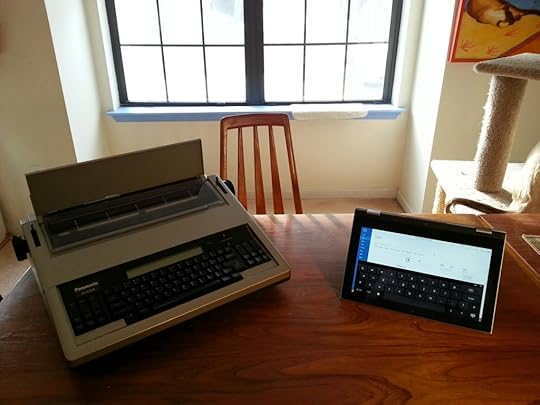Sally Ann Sims's Blog
October 15, 2017
Novelist Next Door #3: Hurricane Alley

A salt pond on the Weekapaug Coast, RI
It’s good to be back at the NND blog after a long hiatus during which I’ve been…well…writing a novel. I started writing Yellow Sky, Emerald Sea three autumns ago during calmer times, meteorologically speaking, on the Atlantic Coast. Publication is set for February 2018.
The new novel centers on the run up to the 80th anniversary of the Hurricane of 1938 in Rhode Island at what you would call “ground zero” of the storm–the Weekapaug Coast. Many outside New England have never heard of the storm. It charged through southern New England and ripped up through Vermont in the time before they named storms after people. High winds and tidal surge were its main tools of destruction. It was before weather forecasters could even track hurricanes well, although one novice meteorologist in Washington, DC, predicted the exact path the storm would take but was ignored by his supervisor. By the time New Yorkers and New Englanders knew the storm was coming, it was on top of them.
As I researched this storm after visiting the Weekapaug coast in 2010, the particular stories of the survivors were so compelling for me I couldn’t forget them. My father, a Rhode Island schoolboy at the time, lived through the storm. I was also haunted by the sight of Fort Mansfield during some conservation biology research I was doing in the vicinity that summer. Eventually, the hurricane story and the Westerly area today began to simmer in my brain and the novel seed sprouted….

View from the top of Fort Mansfield, Napatree Point, Westerly, RI
In 1938, hurricane response efforts were quite different than today. Before and after the storm hit there was no communication between New England and the rest of the country. In the storm’s wake, many transportation routes–roads and rails–were left cratered, displaced, or covered with downed trees and telephone poles. People had to drive–through quite treacherous conditions–to get word out and much needed rescue and recovery help.
An excerpt from the journal of a fictional eyewitness in the forthcoming Yellow Sky, Emerald Sea:
“It rained near every other day that summer of ‘38. And if it didn’t, the sky was clogged with clouds and the air sticky. But that Wednesday was the first bright sunny day since late June. Everyone flocked to the bay, the beaches, the rivers, and the golf courses. All of them were looking to squeeze a final drop of summer out of the first day of autumn. Except for a few seasoned fishermen I knew then. They each told me how the scarlet tint in the dawn sky made them hunker down in ports along the Weekapaug Coast that morning. By mid-afternoon, the sky turned a sickly yellow-green with a reddish overglaze. The crows and gulls disappeared. Then it hit. After a couple hours’ wind and wave chaos, the town I knew vanished.”
This year hurricanes have broken our all over. As I write this piece, there’s another hurricane headed toward Ireland of all places. Storms have wreaked havoc in Texas, Louisiana, Florida, Puerto Rico, the US Virgin Islands, and many other Caribbean Islands.
As we navigate this new weather world and a changing climate, we are blessed to have the tools we have at our disposal, the Internet, hurricane tracking planes, detailed forecasting, and sophisticated logistics organization. But one thing hasn’t changed, the neighborly impulse to reach out to help, either next door or thousands of miles away.

Napatree Beach, Westerly RI. This narrow peninsula between the Atlantic Ocean and Little Narragansett Bay was home to more than 40 families before the Hurricane of 1938. Their stout summer houses were pushed by the rising Atlantic Ocean into the Bay. Some of the residents reached Connecticut still clinging to their roofs.
June 22, 2015
The Novelist Next Door #2
The Story of Understory Installment two of The Novelist Next Door blog
Halt at X has been out in the world for a month now. Thanks to you early-adopter readers! I would love to get your reviews on Amazon and Goodreads, if you are so inclined.
And so….next? A novel set on the Weekapaug Coast of Rhode Island eighty years after of the Hurricane of ’38.
On a short research jaunt there in May I met a talkative old local (Bill) from Pawcatuck, RI, who told me stories I hadn’t found in the books and old newspaper articles I’ve read so far. All while I was tripping over the briars and picking off ticks while stumbling around the hulking remains of Ft. Mansfield at Napatree Point. I did not see Bill stumble once! The plovers were piping loudly, the gulls were crabbing, and the cliff swallows were dive bombing me to steer clear of their nests in the abandoned fort! Great fun was had by all, except, I suppose, the crabs….
So I’ve been idea-gathering by reading, talking, and exploring the area on foot and have a treasure chest full of material, all jumbled together. But nascent novels are squirmy things–you don’t know whether some new idea is part of the superstructure or a minor detail. Or simply a distraction. I can easily get distracted by things I stumble upon in the early phase of research, like the ruins of an old dock off Napatree. Perhaps something can happen there or maybe…. But I continue to gather with an open mind because sometimes an intriguing detail will bloom into a storyline that resolves one of the questions the novel pose s. You just won’t know until you get deeper into the woods with the story.
s. You just won’t know until you get deeper into the woods with the story.
During a hike recently in French Creek State Park–for some reason I seem to like to walk outside when plotting–I was struck by the beauty and complexity of the understory of a healthy Pennsylvania woodland. Not the edges of pocket woods in the suburbs, choked with multiflora rosa, invasive honeysuckle, and garlic mustard, but woodlands whose carpets are graced with spicily fragrant ferns, beech and chestnut oak saplings, and Indian pipes just poking up through the leaf litter. They remind me to be on the lookout for the totally unexpected, the ghost-like, the evocative bit of something that will add an unexpected twist to a scene or a plot. Sometimes small things endure and grow into more immense things–like a mature chestnut oak–after days and years of sun and rain. Which reminds me of the words–put on the page one at a time–that will make up the new novel, growing by their linkage to each word put down before and after.
Anyway, after many months of preparations to publish Halt at X, it’s great to be back in the lush woodland or active sandy beach phase of novel gestation. Activity, color, ideas, and energy–characters, locations, motivations, and twists being created and considered. The scary and exhilarating phase that offers the terrors and blessings of many possibilities. Putting one thing next to what you already have and seeing what happens.
Happy summer wanderings to you.
-Sally
March 26, 2015
The Novelist Next Door #1
TOOLS OF THE TRADE Installment one of The Novelist Next Door blog
Novel writing tools circa 1985 (left) and 2015 (right). I’ve been at this for a while….
In this NND blog, I’ll be musing about novels, novel writing, and novelists next door. We’re out there. Right in your own neighborhood! Reading and writing novels.
A little about me to get going….
I have degrees in English (always a good excuse to write fiction) and Conservation Biology (always a good excuse to wander around in the woods or explore the low tide line). Art, Science, and Literature have encircled my life for decades.
My heroes as a teenager were Henry David Thoreau, John Muir, and Vincent Van Gogh. Renaissance people. Writer-artists and scientist-writers and philosopher-naturalists. Nature lovers all. I used to ride my Morgan-Quarter Horse cross gelding around Walden Pond in the olden days. I enjoyed hearing that this wilderness loving man, HDT, facing life directly at The Pond, used to go back home once a week to do his laundry.
The year I spent at the University of Maine, I discovered the wonderful Quebec novels of the French-Canadian novelist Gabriella Roy. These books–I remember The Tin Flute in particular–made me wonder at how one infuses emotion–love, pain, striving, desire–into literature and what it would be like to be able to do that myself.
My novel writing journey began with an inspiration from a canoe trip I took on the Noatak River above the Arctic Circle in Alaska the summer that Prince Charles married Diana Spencer. That trip gave me the kernel of an idea for my first novel, STAKING A CLAIM, written when electronic typewriters with a single-line LCD were state-of-the-art (see my old pal above left). Now I write on a 2-in-1 (my new pal above right) using Twine storyboarding software. Although index cards are still in the mix for me when starting on a new project.
Through STAKING and a subsequent novel (THE LAST ACRE), I learned what the heck goes into writing a novel: character development, plot building, point of view, dialogue, scene structure, going for an effect that is beyond the sum of the words written. Is it ever possible to learn this craft completely? Shout out if you have.
Write. Revise. Write. Revise. Repeat, repeat, repeat. Ok, I’ve got something here! And now HALT AT X, my debut novel, is in the final publishing stages for a spring 2015 launch. I’m starting on the next novel in the series set on the Weekapaug Coast of Rhode Island.
But when it comes to tools, the instruments of writing, I think of novelists long since dead who had no access to anything electronic or even electric for that matter. Those instruments don’t help at all without a huge dose of heart. Heart to get the story on the page. Heart to thrash it out when the way forward is murky at its clearest. Heart to see clearly into the workings of the character most unlike you. Heart to go on when the whole thing turns into something else right under your nose. Heart that builds the more you write and rewrite. Heart period. Best tool for a novelist. Developing heart may be the purpose of all the things with meaning that we are called to do.
That’s all for now. Novel readers and writers among you: send comments and suggestions of future blog topics of interest. I’ve got topics up my sleeve, but I what to hear what you’re thinking…and reading. I expect to be blogging seasonally, more or less.
Happy spring to all…it’s been a long winter.
The Novelist Next Door
TOOLS OF THE TRADE Installment one of Novelist Next Door blog
Novel writing tools circa 1985 (left) and 2015 (right). I’ve been at this for a while….
In this NND blog, I’ll be musing about novels, novel writing, and novelists next door. We’re out there. Right in your own neighborhood! Reading and writing novels.
A little about me to get going….
I have degrees in English (always a good excuse to write fiction) and Conservation Biology (always a good excuse to wander around in the woods or explore the low tide line). Art, Science, and Literature have encircled my life for decades.
My heroes as a teenager were Henry David Thoreau, John Muir, and Vincent Van Gogh. Renaissance people. Writer-artists and scientist-writers and philosopher-naturalists. Nature lovers all. I used to ride my Morgan-Quarter Horse cross gelding around Walden Pond in the olden days. I enjoyed hearing that this wilderness loving man, HDT, facing life directly at The Pond, used to go back home once a week to do his laundry.
The year I spent at the University of Maine, I discovered the wonderful Quebec novels of the French-Canadian novelist Gabriella Roy. These books–I remember The Tin Flute in particular–made me wonder at how one infuses emotion–love, pain, striving, desire–into literature and what it would be like to be able to do that myself.
My novel writing journey began with an inspiration from a canoe trip I took on the Noatak River above the Arctic Circle in Alaska the summer that Prince Charles married Diana Spencer. That trip gave me the kernel of an idea for my first novel, STAKING A CLAIM, written when electronic typewriters with a single-line LCD were state-of-the-art (see my old pal above left). Now I write on a 2-in-1 (my new pal above right) using Twine storyboarding software. Although index cards are still in the mix for me when starting on a new project.
Through STAKING and a subsequent novel (THE LAST ACRE), I learned what the heck goes into writing a novel: character development, plot building, point of view, dialogue, scene structure, going for an effect that is beyond the sum of the words written. Is it ever possible to learn this craft completely? Shout out if you have.
Write. Revise. Write. Revise. Repeat, repeat, repeat. Ok, I’ve got something here! And now HALT AT X, my debut novel, is in the final publishing stages for a spring 2015 launch. I’m starting on the next novel in the series set on the Weekapaug Coast of Rhode Island.
But when it comes to tools, the instruments of writing, I think of novelists long since dead who had no access to anything electronic or even electric for that matter. Those instruments don’t help at all without a huge dose of heart. Heart to get the story on the page. Heart to thrash it out when the way forward is murky at its clearest. Heart to see clearly into the workings of the character most unlike you. Heart to go on when the whole thing turns into something else right under your nose. Heart that builds the more you write and rewrite. Heart period. Best tool for a novelist. Developing heart may be the purpose of all the things with meaning that we are called to do.
That’s all for now. Novel readers and writers among you: send comments and suggestions of future blog topics of interest. I’ve got topics up my sleeve, but I what to hear what you’re thinking…and reading.
Happy spring to all…it’s been a long winter.
February 24, 2015
Essays
I also write essays. You can check out a sampling of my published essays by clicking on the hyperlinks.
Topics range from:
Learning to play the saxophone



